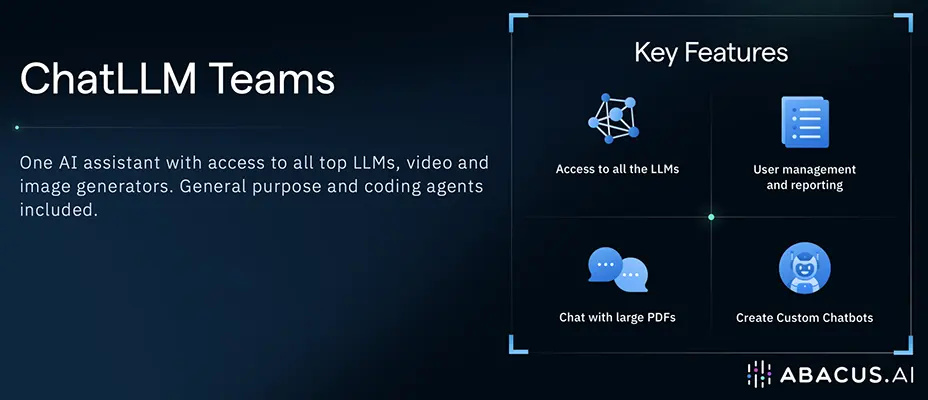AI Updates: October 21, 2025
📰 Weekly AI Developments Post
This week’s AI landscape revealed how rapidly innovation is colliding with real-world limits — from OpenAI’s “Spicy ChatGPT” and Google’s cancer-research breakthroughs to a global energy crunch driven by AI data centers. The AI For Humans episode captured the duality perfectly: creativity and controversy accelerating in tandem. OpenAI’s move into verified-adult AI experiences raised urgent questions about governance, liability, and safety, while Google’s DeepMind collaboration demonstrated AI’s capacity for genuine scientific discovery. Together, they illustrate how 2025’s AI frontier is expanding across both moral and material boundaries.
Across industry, the stories that followed reinforce that theme. The Wall Street Journal traced how data-center power demands are reshaping energy policy, while Fast Company spotlighted breakthroughs in applied AI — from quantum computing and agentic systems to AI-driven entertainment and startup culture. Meanwhile, TechTarget detailed how AI orchestration, benchmarking, and governance are becoming board-level priorities for every business. For SMB executives, this week’s takeaway is clear: AI’s growth is no longer just technical — it’s strategic, ethical, and infrastructural. The challenge is to innovate boldly while keeping both humanity and sustainability in view.

OpenAI’s “Spicy ChatGPT,” Google’s Scientific Breakthroughs, and AI Video Advances
AI For Humans (Oct 17, 2025)
OpenAI sparked controversy this week after Sam Altman announced adult-content capabilities for ChatGPT, signaling a new era of “verified adult” AI experiences. While critics like Mark Cuban warned of risks to minors, others noted this reflects a broader debate about freedom, safety, and responsibility in generative AI. Alongside that, OpenAI’s Sora 2 received major updates — including 25-second video generations and storyboard scene control — demonstrating rapid iteration, though still prone to visual inconsistencies. Meanwhile, the company’s financials reveal both surging revenue and mounting losses, estimated near $20 billion annually, raising sustainability questions as the race for dominance accelerates.
In contrast, Google delivered tangible progress in applied science. Its DeepMind-linked project Cell2Sentence 27B, trained with Yale, generated a novel hypothesis for cancer cell behavior that scientists have now validated in living tissue — a potential path toward new cancer treatments. Google also previewed Gemini 3.0 Pro, reportedly surpassing GPT-5-level performance in early coding and game-generation benchmarks, and unveiled Veo 3.1, a major text-to-video upgrade with improved texture realism, physics, and character consistency. These releases reinforce Google’s push toward real-world impact — from fusion research to life-saving therapies — while OpenAI pursues more commercial and consumer-facing models.
Elsewhere, Anthropic launched Claude 4.5 Haiku, a faster, cheaper small model nearing GPT-5’s coding performance, Anduril debuted its Eagle Eye military AR headset, and Boston Dynamics’ Spot robot demonstrated autonomous manipulation of heavy objects — all evidence of AI’s expanding physical and operational reach. The episode closed by warning that over half of online content is now AI-generated (“dead internet” era), urging human-in-the-loop practices and creative authenticity amid a flood of synthetic media.
Relevance for Business
For SMB executives, this episode highlights both the speed of AI commercialization and the shifting boundary between entertainment, productivity, and science. OpenAI’s policy shift shows how AI regulation, content moderation, and liability will directly affect brand and customer trust. Google’s breakthroughs illustrate AI’s potential to create new intellectual property and R&D efficiencies, while Sora 2 and Veo 3.1 point to near-term opportunities in AI-assisted marketing, training, and prototyping video. The broader message: innovation and governance must evolve together, as AI’s creative and operational frontiers expand faster than its guardrails.
Calls to Action
🔹 Assess AI policy implications — Review internal guidelines for responsible use, particularly around content generation, customer data, and brand safety.
🔹 Experiment with AI video tools like Sora 2 or Veo 3.1 for affordable marketing pilots, but maintain strict human review and disclosure.
🔹 Monitor Google’s Gemini 3.0 rollout — early performance suggests new options for small-business coding, search, and data-analysis automation.
🔹 Prioritize authenticity in communication — clearly label AI-assisted content to preserve audience trust in a “synthetic-media” landscape.
🔹 Prepare for AI infrastructure costs — as models scale, factor compute and subscription expenses into 2026 budgeting and ROI planning.
Summary by ReadAboutAI.com
https://www.youtube.com/watch?v=GkFVilXepXU: October 21, 2025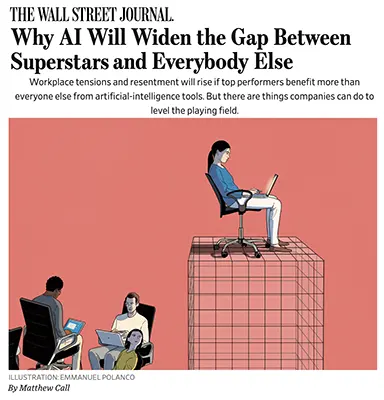
💼 Why AI Will Widen the Gap Between Top Performers and Everyone Else
Wall Street Journal (Oct 12, 2025)
According to Matthew Call of Texas A&M University, AI tools will widen productivity gaps between star employees and average performers, not close them. High performers leverage AI better due to domain expertise, disciplined workflows, and experimentation autonomy, leading to disproportionately higher returns on AI usage.
AI’s invisible assistance also reinforces status bias — managers credit superstars for AI-boosted output while doubting similar results from others. Without intervention, this dynamic could foster resentment and retention issues, undermining collaboration and morale.
Relevance for Business:
SMBs must proactively democratize AI literacy to avoid workplace inequality. Training, open AI experimentation, and transparent evaluation systems can prevent top-performer dominance and boost overall productivity.
Calls to Action:
🔹 Implement AI sandbox programs for all employees.
🔹 Train teams in prompt engineering and AI evaluation.
🔹 Update performance reviews to account for AI-assisted output.
Summary by ReadAboutAI.com
https://www.wsj.com/lifestyle/workplace/ai-workplace-tensions-what-to-do-c45f6b51: October 21, 2025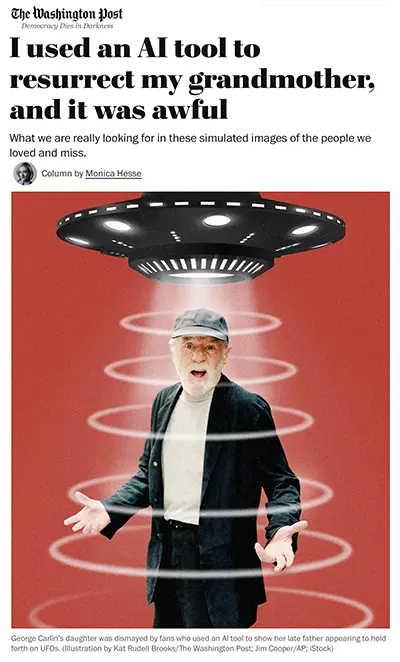
“I Used an AI Tool to Resurrect My Grandmother — and It Was Awful”
The Washington Post (Oct 12, 2025)
In this deeply personal essay, a writer recounts using AI resurrection technology to recreate her late grandmother’s likeness and voice. The experience, powered by video synthesis and voice cloning tools, initially promised comfort but quickly turned unsettling. The simulation captured her grandmother’s face but missed her warmth, humor, and essence — leaving the author describing the encounter as “emotionally hollow and uncanny.”
The article raises urgent questions about digital afterlife ethics, consent, and emotional harm caused by synthetic memorials. Experts warn that these systems exploit grief and could erode boundaries between memory and manipulation, especially as generative models become indistinguishable from reality.
Relevance for Business:
For SMB leaders, this piece highlights the ethical and reputational risks of deploying emotionally charged AI products. Businesses creating customer experiences or legacy-focused tools must balance innovation with sensitivity, privacy, and emotional authenticity.
Calls to Action:
🔹 Establish ethical review frameworks for emotionally sensitive AI use cases.
🔹 Be transparent about AI-generated recreations and obtain explicit consent.
🔹 Avoid emotional exploitation in marketing or customer engagement designs.
Summary by ReadAboutAI.com
https://www.washingtonpost.com/style/2025/10/13/ai-loved-ones-grandmother/: October 21, 2025
🎭 AI Videos of Dead Celebrities Horrify Families
The Washington Post (Oct 11, 2025)
OpenAI’s Sora 2 has ignited outrage with its ability to generate realistic AI videos of deceased celebrities and historical figures without family consent. Clips of Malcolm X, Martin Luther King Jr., and Robin Williams have gone viral, depicting them in crude or disturbing scenarios. While OpenAI claims to permit depictions of “historical figures” under free speech, families and advocacy groups argue it’s a violation of dignity, likeness rights, and legacy. The article highlights a growing crisis over synthetic resurrection — the creation of digital clones of the dead for entertainment or parody — and the absence of strong legal protections for posthumous identity rights.
Experts warn that this wave of deepfake memorialization threatens public trust, damages reputations, and could invite lawsuits. Even Hollywood agencies and the Motion Picture Association have demanded stronger controls to protect creators and estates from exploitation.
Relevance for Business:
This story underscores the need for ethical and legal frameworks around AI-generated likenesses, especially for media, entertainment, and marketing sectors. SMBs using generative video or marketing tools must prioritize consent, attribution, and authenticity to avoid reputational and legal fallout.
Calls to Action:
🔹 Review internal policies on AI-generated likenesses and use of public figures.
🔹 Use clear labeling for synthetic or AI-generated content.
🔹 Monitor evolving AI rights legislation to ensure compliance in media use.
Summary by ReadAboutAI.com
https://www.washingtonpost.com/technology/2025/10/11/openai-sora-dead-celebrities-ai/: October 21, 2025
💔 Does Having an AI Boyfriend Count as Cheating?
The Cut (Oct 10, 2025)
Angelina Chapin explores the emerging gray zone between digital intimacy and infidelity. Through interviews with couples engaging emotionally or sexually with AI chatbots, the article highlights evolving norms around emotional attachment, secrecy, and consent. Some partners view AI relationships as harmless fantasy or therapy; others see them as emotional cheating that displaces human intimacy.
Therapists quoted in the piece note that secrecy and emotional substitution are key indicators of infidelity — whether the “partner” is human or AI. The rise of AI romantic companions reveals both unmet emotional needs and the growing blur between simulation and reality.
Relevance for Business:
This trend highlights AI’s influence on consumer behavior, emotional well-being, and relationship ethics — vital for industries in mental health, tech design, and HR policy as personal and professional boundaries blur.
Calls to Action:
🔹 Track how emotional AI use impacts workplace culture and wellness.
🔹 Review ethical design standards for emotionally responsive AI tools.
🔹 Educate employees on AI-human relationship boundaries and data privacy.
Summary by ReadAboutAI.com
https://www.thecut.com/article/is-ai-boyfriend-cheating-chatbot-chatgpt-relationship.html: October 21, 2025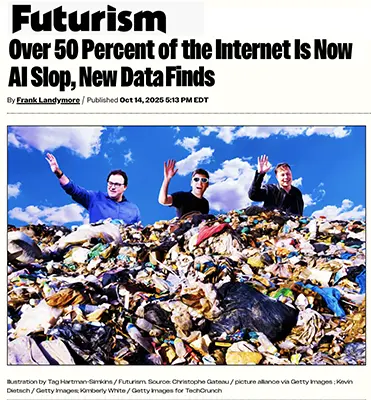
🌐 “Over 50% of the Internet Is Now AI Slop”
Futurism (Oct 14, 2025)
New research shows that over half of the active web now consists of AI-generated or AI-augmented content, leading experts to dub it “AI slop.” This content—ranging from low-quality blogs to fake reviews and spam sites—has polluted search results, overwhelmed ad networks, and compromised the trustworthiness of online information.
The study, based on web-crawling data from Originality.ai and University of Waterloo researchers, found that AI-generated pages increased 700% in 2025, especially on affiliate networks and SEO farms. Even legitimate companies struggle to ensure their marketing and documentation stay human-authored amid the glut of generative material.
Relevance for Business:
For SMBs, the “AI slop” epidemic signals a new phase of digital noise and declining information reliability. Maintaining authentic, verifiable, and high-quality content will become a competitive differentiator in brand trust and search visibility.
Calls to Action:
🔹 Audit web content for originality and factual accuracy.
🔹 Use human-in-the-loop review to ensure authenticity.
🔹 Clearly label AI-assisted materials on corporate sites.
Summary by ReadAboutAI.com
https://futurism.com/artificial-intelligence/over-50-percent-internet-ai-slop: October 21, 2025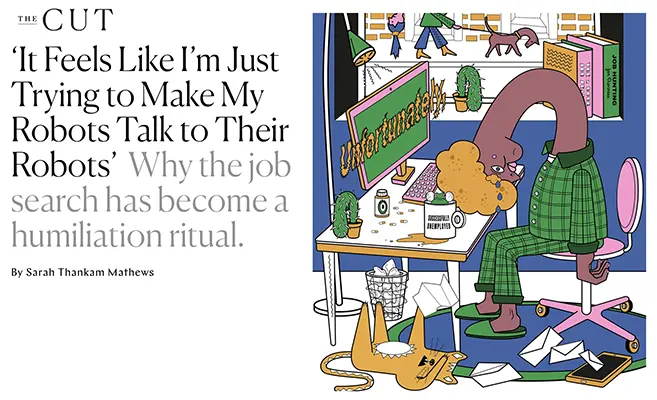
💼 “The Job Search Has Become a Humiliation Ritual”
The Cut (Oct 2025)
Writer Sarah Thankam Mathews paints a stark portrait of the 2025 job market — a landscape where AI automation dominates hiring and human connection erodes. Job seekers face automated rejections within seconds, AI interviewers, and résumé filters that favor algorithmic pattern-matching over human potential.
The piece argues that AI has turned job searching into a dehumanizing loop, where applicants and employers alike rely on bots, erasing empathy and fairness. Structural job insecurity, stagnant wages, and mental strain compound this “ritual humiliation.” Mathews warns that if workers fail to reclaim solidarity, automation could permanently redefine labor as an algorithmic contest.
Relevance for Business:
For SMB executives, this serves as a cautionary lens on AI’s unintended cultural impact. Efficient does not always mean humane—ethical automation and transparent hiring can strengthen brand reputation and trust.
Calls to Action:
🔹 Audit hiring tools for AI bias and over-automation.
🔹 Maintain human touchpoints in recruitment and employee communication.
🔹 Champion ethical tech policies to attract and retain talent.
Summary by ReadAboutAI.com
https://www.thecut.com/article/job-search-unemployment-stories.html: October 21, 2025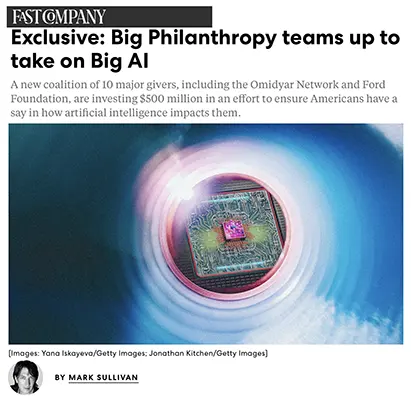
Big Philanthropy Takes on Big AI
Fast Company (October 14, 2025)
Ten of the world’s largest philanthropic organizations — including the Ford Foundation, Omidyar Network, MacArthur Foundation, and Mozilla Foundation — have launched a $500 million, five-year initiative called Humanity AI. The coalition aims to ensure that artificial intelligence serves people and communities, not just corporate and investor interests.
The fund will support organizations like EPIC (Electronic Privacy Information Center) and the Berkeley Labor Center to strengthen privacy protections, measure AI’s workforce impacts, and train labor advocates. It will also fund groups like AI Now that advocate for public accountability in AI policy, and invest in tools that protect creative workers’ intellectual property amid growing risks from generative AI.
According to Omidyar Network president Michele Jawando, the goal is to “pull up a few more chairs at the table” so ordinary citizens — not just Big Tech — can shape AI’s future. MacArthur Foundation president John Palfrey emphasized that while philanthropic funding can’t match Silicon Valley’s scale, collective action can rebalance AI development toward human flourishing. Humanity AI plans to start grantmaking by late 2025, with Rockefeller Philanthropy Advisors managing the pooled fund.
Relevance for Business
For SMB executives and managers, this initiative signals a major shift in the AI landscape: ethical, equitable, and human-centered innovation is becoming a mainstream expectation. As regulation and social scrutiny increase, aligning business AI strategies with transparency, privacy, and workforce empowerment will not only mitigate reputational risk but also open doors to new partnerships and funding opportunities.
Calls to Action
🔹 Audit AI practices to ensure fairness, privacy, and workforce protection are built in from the start.
🔹 Engage with civic and academic initiatives (like Humanity AI’s partners) that promote responsible technology use.
🔹 Support ethical sourcing of AI tools — prioritize vendors who demonstrate accountability and inclusivity.
🔹 Anticipate public pressure and policy changes by embedding human-centered AI values into company culture.
🔹 Empower employees with AI literacy training to ensure they participate — not just adapt — in the AI-driven workplace.
Summary by ReadAboutAI.com
https://www.fastcompany.com/91420384/exclusive-philanthropy-omidyar-artificial-intelligence-ford-foundation: October 21, 2025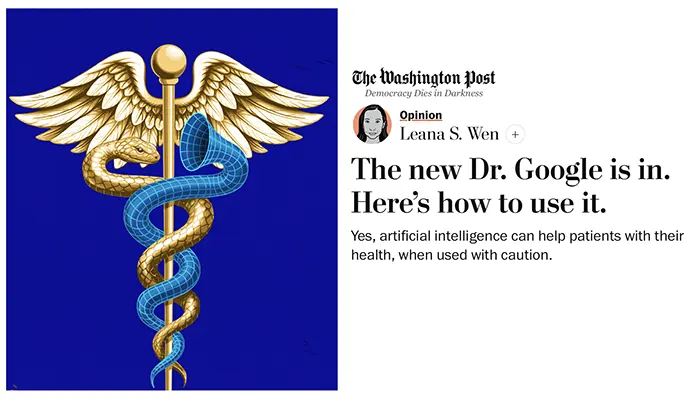
“Guidance on Using AI Chatbots for Your Health Issues”
The Washington Post (Oct 7, 2025)
Dr. Leana Wen explores how patients can safely use AI chatbots like ChatGPT, Gemini, Claude, and Perplexity for health-related questions. While AI can explain medical jargon, summarize doctor notes, and help patients prepare for appointments, it carries risks of misinformation and hallucination.
Experts advise users to treat AI as a complement, not a replacement, for medical judgment. Key safeguards include avoiding personal data sharing, cross-checking multiple models, and consulting healthcare professionals for critical symptoms.
Relevance for Business:
Healthcare and wellness SMBs should establish clear AI usage policies for patient interactions. Transparent, human-supervised chatbot systems can enhance patient engagement while reducing liability risk.
Calls to Action:
🔹 Design AI systems that support, not replace professional care.
🔹 Protect patient privacy—avoid storing sensitive medical data.
🔹 Offer disclaimers and multi-model verification for AI-generated responses.
Summary by ReadAboutAI.com
https://www.washingtonpost.com/opinions/2025/10/14/ai-chatbots-health-care-diagnoses/: October 21, 2025ChatLLM: “All-in-One AI for $10/Month”
I Replaced $500/Month in AI Subscriptions with This $10 Secret – AI Companies HATE This, Julia McCoy (YouTube), Oct 4, 2025
Summary
Julia McCoy reviews ChatLLM (by Abacus.ai) as an all-in-one AI platform that consolidates access to multiple major models (e.g., GPT, Claude, Gemini, Grok, DeepSeek) plus image/video generation, a VS Code–style coding environment, and agentic workflows—for $10/month. A core feature, “Route LLM,” automatically routes each request to the model best suited for the task (e.g., creative writing, analysis, real-time info), aiming to remove the guesswork and tab-switching common to multi-tool stacks. McCoy positions this as a remedy for rising tool bloat and subscription costs (she cites ~$487/month previously across ChatGPT Plus, Claude Pro, Midjourney, Runway, Perplexity, etc.).
Beyond text, the platform functions as a creative studio: Seedream, Nano Banana, Flux, Ideogram for images; Luma and Runway for video—enabling image-to-video and storyboard-style content building. A “Humanize” feature targets the problem of robotic tone, iteratively refining style and flow to read more authentically human. For developers and no-coders, Code LLM adds a browser-based VS Code editor with code generation, debugging, and refactoring, used to prototype dashboards or web apps directly in the platform.
McCoy highlights Deep Agent, a multi-step AI agent that can research markets, generate analyses and charts, build presentations, and ship web assets—claiming consulting-grade output in minutes. She underscores collaboration at scale (e.g., unlimited team members, real-time collaboration, Slack/Teams/Drive/OneDrive integration) and usage allocations (e.g., ~2M compute points/month, illustrative equivalents like millions of tokens, hundreds of images, dozens of videos, with rollover and purchasable add-ons). Her thesis: the platform cuts cost and friction while expanding capability by unifying models, media tools, agents, and dev workflows in one place.
Relevance for Business
For SMB leaders, the proposition is cost consolidation, workflow speed, and lower tool-chain complexity. Automatic model routing can raise quality without constant tool selection, while built-in creative/video and code capabilities support marketing, internal training, rapid prototyping, and ops automation. However, executives should also consider governance (data handling, privacy, IP), vendor lock-in, rate limits/SLAs, and model-selection transparency before centralizing critical content and code creation on a single platform.
Calls to Action
🔹 Quantify ROI: Compare current AI/tool spend and throughput vs. a single-platform trial (30–45 days) with baseline KPIs (content velocity, campaign lift, engineering cycle time).
🔹 Pilot safely: Start with non-sensitive projects (marketing assets, prototypes). Define human-in-the-loop review and disclosure for AI-assisted outputs.
🔹 Check data policy: Review privacy, retention, training, and IP terms for uploads, prompts, and generated code/assets.
🔹 Stress-test routing: Run a task matrix (creative, analytical, realtime, code) and verify the route choices and output quality; document when manual model selection is better.
🔹 Build guardrails: Implement content, brand-voice, and security guidelines; set access controls and audit logs for team usage.
🔹 Plan continuity: If consolidating tools, draft a vendor-exit plan (exports, format compatibility, API access) to avoid lock-in risk.
Summary by ReadAboutAI.com
https://www.youtube.com/watch?v=jyIAfP3cw-0: October 21, 2025
⚙️ A Vast Divergence in America’s Future Industries
The Washington Post (Oct 13, 2025)
America’s AI sector is booming while manufacturing continues to decline, revealing a deep divide in how economic progress is distributed. Despite tariffs and federal incentives, manufacturing has lost 38,000 jobs this year, while AI investments — in chips, data centers, and cloud infrastructure — are soaring by double digits. Analysts warn that this imbalance could erode middle-class stability as AI-driven industries generate wealth but few traditional jobs.
The AI boom has fueled surges in semiconductor demand and stock valuations, but critics note that data centers employ hundreds, not thousands, compared to factories. As a result, the shift toward digital industries may widen the economic gap between blue-collar and tech sectors.
Relevance for Business:
SMB executives should understand how this divergence affects talent pipelines, supply chains, and automation opportunities. AI-driven productivity gains could offset some losses but require retraining, cross-sector partnerships, and energy management planning.
Calls to Action:
🔹 Prepare for AI-driven reshoring and automation in production lines.
🔹 Invest in employee reskilling programs for AI integration.
🔹 Evaluate how manufacturing downturns could reshape your vendor ecosystem.
Summary by ReadAboutAI.com
https://www.washingtonpost.com/business/2025/10/13/manufacturing-artificial-intelligence/: October 21, 2025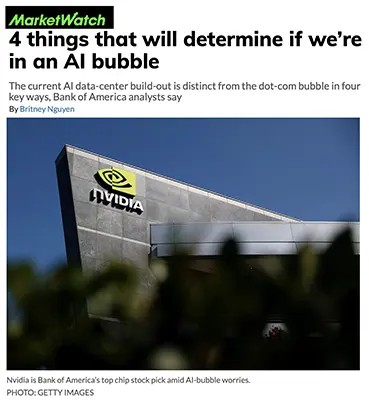
📉 Are We in an AI Bubble?
MarketWatch (Oct 13, 2025)
Bank of America analysts argue that today’s AI infrastructure boom is not a repeat of the dot-com bubble. Despite record spending on data centers, GPUs, and semiconductors, analysts identify four differences:
- High Utilization: AI compute demand remains strong, avoiding the “dark fiber” overcapacity of the 1990s.
- Cash Flow-Funded Growth: Cloud providers like Microsoft, Google, and Amazon are funding expansion from profits, not debt.
- Falling Interest Rates: Cheaper capital supports sustained investment.
- Rational Valuations: AI leaders like Nvidia trade below historic dot-com P/E multiples.
The report concludes that while risks exist (notably tariffs and energy constraints), the AI build-out is fundamentally productive, not speculative.
Relevance for Business:
SMBs should view AI infrastructure growth as a foundation for future opportunity, not a bubble to fear. This expansion will lower compute costs and improve AI accessibility over time.
Calls to Action:
🔹 Treat AI infrastructure as a stable long-term asset class.
🔹 Monitor U.S.–China chip and tariff tensions.
🔹 Reinvest cost savings from AI into workforce and process innovation.
Summary by ReadAboutAI.com
https://www.marketwatch.com/story/four-things-that-will-determine-if-were-in-an-ai-bubble-df96147d: October 21, 2025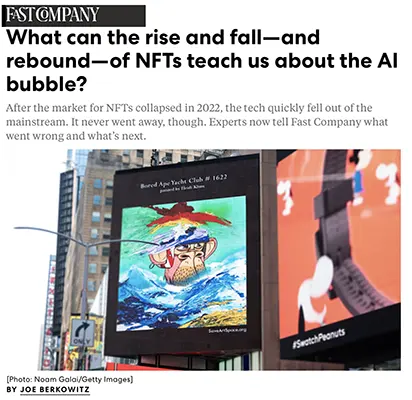
💰 NFTs in the Age of AI
Fast Company (Oct 2025)
Once tech’s hottest craze, NFTs (non-fungible tokens) have largely been absorbed into the broader AI and digital ownership economy. As generative AI floods the market with digital art and assets, NFT platforms are redefining themselves as authentication and provenance layers — verifying originality in a world of infinite AI creation. The article notes that while NFT hype has cooled, blockchain’s utility in certifying authenticity is rising again amid deepfake and AI-content concerns.
Leading platforms like OpenSea and SuperRare are pivoting toward AI art verification, integrating generative models and digital fingerprinting to track creation lineage. Experts see this as a second act for NFTs — less about speculation, more about establishing trust in synthetic media ecosystems.
Relevance for Business:
For SMBs in marketing or design, NFTs and blockchain can provide proof of originality in brand assets, contracts, and customer engagement tokens, helping protect against AI plagiarism and brand misuse.
Calls to Action:
🔹 Explore blockchain tools for verifying AI-generated content.
🔹 Register key creative assets on verifiable digital ledgers.
🔹 Consider NFT-based loyalty systems for transparent brand engagement.
Summary by ReadAboutAI.com
https://www.fastcompany.com/91417122/what-happened-with-nfts-lessons-ai: October 21, 2025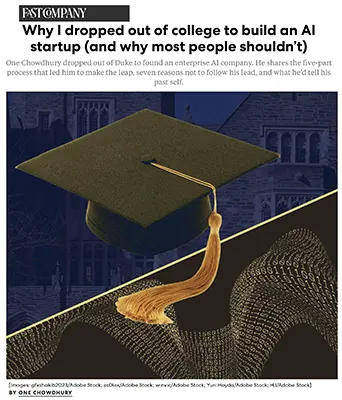
💡 Why I Dropped Out to Build an AI Startup
Fast Company (Oct 9, 2025)
One Chowdhury, cofounder of Octolane AI, recounts leaving Duke University to build a Y Combinator–backed AI CRM system aimed at replacing Salesforce. His essay outlines a five-part framework—conviction, timing, traction, partnership, and runway—for deciding whether to found a startup.
Chowdhury argues that the AI revolution is unfolding faster than any technological wave before it and that waiting risks irrelevance. Yet, he warns against romanticizing the dropout-founder myth: “Dropping out is wrong for 99% of people.” True entrepreneurship requires urgency, validated demand, and a mission worth personal sacrifice.
Relevance for Business:
This first-person narrative captures the mindset of next-generation founders driving AI disruption. For SMB leaders, it’s a reminder that agility, conviction, and speed-to-market are decisive in the AI era.
Calls to Action:
🔹 Embrace startup agility within corporate strategy.
🔹 Encourage internal innovation teams to act with urgency.
🔹 Partner with AI-first startups solving domain-specific pain points.
Summary by ReadAboutAI.com
https://www.fastcompany.com/91418379/why-i-dropped-out-of-college-to-found-an-ai-startup: October 21, 2025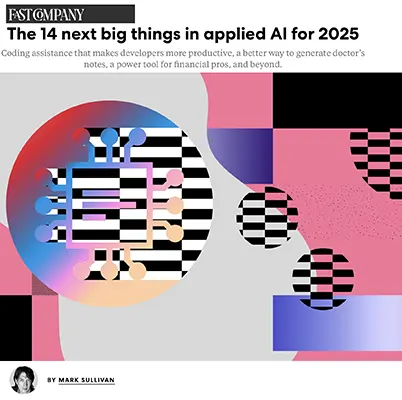
🚀 The 14 Next Big Things in Applied AI
Fast Company (Oct 14, 2025)
Mark Sullivan’s roundup of Fast Company’s 2025 “Next Big Things in Tech” honorees spotlights applied AI innovations transforming business sectors. Highlights include:
- Alta: Personal AI stylist that customizes outfits from user wardrobes.
- Ambience Healthcare: Ambient “AI scribe” that automates medical notes.
- Bolt: Natural-language “vibe coding” for instant app creation.
- Cradle: Generative AI for protein engineering and drug design.
- Hebbia: Financial AI that extracts insights from unstructured documents.
- Typeface: End-to-end AI marketing campaigns that preserve brand tone.
- Vermillio: Deepfake and voice-cloning protection for creators.
Collectively, these tools show how applied AI is shifting from experimentation to specialization, embedding itself deeply into industries like healthcare, logistics, and software development.
Relevance for Business:
For SMB leaders, the key takeaway is that AI maturity now lies in integration, not hype. Businesses that deploy industry-specific AI (for HR, finance, logistics, or creative operations) will see faster ROI and stronger differentiation.
Calls to Action:
🔹 Audit existing processes for AI specialization opportunities.
🔹 Evaluate tools like Typeface, Ambience, and Bolt for automation gains.
🔹 Implement IP protection systems like Vermillio if using AI-generated media.
Summary by ReadAboutAI.com
https://www.fastcompany.com/91411008/applied-ai-next-big-things-in-tech-2025: October 21, 2025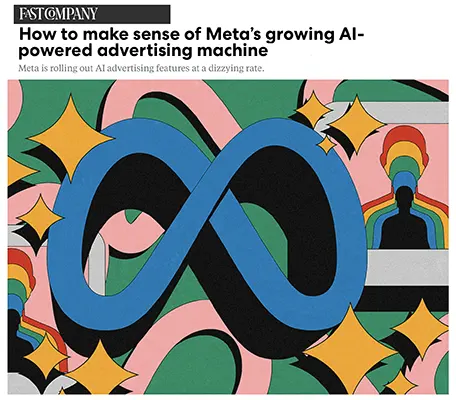
📈 Meta’s Fully Automated Ad Machine
Fast Company (Oct 2025)
Meta plans to fully automate its advertising ecosystem by 2026, using five major AI breakthroughs: Advantage Plus Shopping Campaigns, Meta Lattice, Generative AI for Ads, Andromeda infrastructure, and GEM (Generative Ads Recommendation Model). The system autonomously creates, optimizes, and targets ad campaigns, reducing reliance on human creatives. Meta executives claim this shift will increase ad conversions by up to 5% and make marketing more personalized and data-driven.
New tools include virtual try-ons, AI-generated music, persona-based ads, and AI-informed targeting from its digital assistant. While Meta insists agencies will remain part of the ecosystem, the move signals a future of hyper-automated, closed-loop advertising.
Relevance for Business:
SMB marketers must prepare for AI-dominated advertising ecosystems, where creative design, targeting, and testing are automated. Understanding Meta’s platform will be essential for efficient campaign management.
Calls to Action:
🔹 Test Meta’s Advantage Plus and AI Creative tools early.
🔹 Track ad performance changes driven by AI automation.
🔹 Develop human oversight roles for ethical and brand consistency.
Summary by ReadAboutAI.com
https://www.fastcompany.com/91415443/how-to-make-sense-of-metas-growing-ai-powered-advertising-machine: October 21, 2025
🔩 Oracle and AMD Partner on New AI Chip Deal
Wall Street Journal (Oct 14, 2025)
Oracle and Advanced Micro Devices (AMD) have announced a major partnership to deploy 50,000 MI450 GPUs in Oracle’s global data centers starting in Q3 2026. The deployment will consume 200 megawatts of compute capacity, marking one of the largest single rollouts of AMD’s next-generation AI chips. Both companies aim to extend the agreement beyond 2027, signaling a long-term commitment to AI infrastructure scaling.
This collaboration follows AMD’s five-year partnership with OpenAI, which could generate tens of billions in revenue. Oracle, meanwhile, is positioning itself as a top-tier AI infrastructure provider, having recently signed a $300 billion cloud deal with OpenAI — one of the largest in history. The MI450 rollout is designed to compete directly with Nvidia’s Vera Rubin server chips, intensifying the AI hardware race.
Relevance for Business:
For SMB executives, this partnership represents a critical shift toward multi-chip AI ecosystems. Dependence on Nvidia may decline as Oracle and AMD expand compute capacity — potentially lowering prices and improving access to enterprise-grade AI infrastructure.
Calls to Action:
🔹 Monitor AMD–Oracle pricing as competition pressures Nvidia’s dominance.
🔹 Assess cloud provider flexibility for multi-vendor GPU access.
🔹 Prepare to leverage new MI450-based AI services launching in 2026.
Summary by ReadAboutAI.com
https://www.wsj.com/tech/oracle-amd-partner-on-new-ai-chip-deal-56f4f96c: October 21, 2025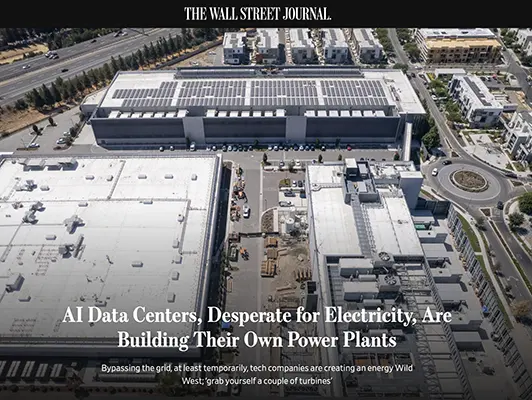
⚡ AI Data Centers, Desperate for Electricity, Are Building Their Own Power Plants
The Wall Street Journal (Oct 15, 2025)
AI infrastructure demand has grown so massive that major tech companies — including OpenAI, Oracle, xAI, Meta, and Equinix — are now building their own natural-gas power plants to fuel data centers. This “Bring Your Own Power” movement is transforming U.S. energy strategy as the grid fails to keep up with AI’s voracious power appetite.
Projects like OpenAI’s $500B Stargate site in West Texas and Elon Musk’s Colossus facilities in Memphis will consume enough power to light entire cities. Experts warn that by 2028, AI data centers could use up to 12% of all U.S. electricity, accelerating fossil fuel reliance despite renewable goals. President Trump has declared a national energy emergency to fast-track new energy infrastructure, but grid expansion remains years behind.
Relevance for Business:
This story underscores how AI’s compute boom is reshaping U.S. energy economics. For SMB leaders, it signals likely increases in cloud service costs, supply constraints, and the strategic importance of energy diversification and sustainability positioning.
Calls to Action:
🔹 Evaluate cloud providers’ energy sourcing and stability.
🔹 Incorporate energy cost volatility into AI budgeting.
🔹 Explore green AI partnerships to offset carbon impacts.
Summary by ReadAboutAI.com
https://www.wsj.com/business/energy-oil/ai-data-centers-desperate-for-electricity-are-building-their-own-power-plants-291f5c81: October 21, 2025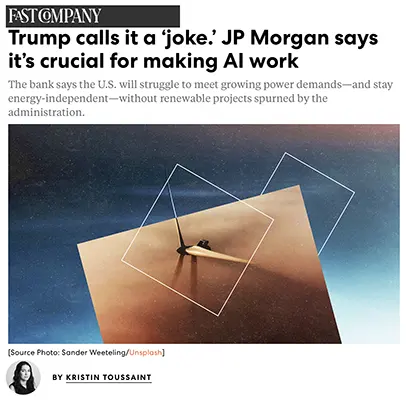
“Trump Calls It a ‘Joke.’ JPMorgan Says It’s Crucial for Making AI Work”
Fast Company(Oct 13, 2025)
While former President Trump dismissed data labeling as a “waste of American labor,” JPMorgan Chase and AI firms argue it’s one of the most essential foundations of AI performance. Data labeling—the human task of cleaning, tagging, and verifying training data—remains vital even as automation expands.
Executives at JPMorgan, OpenAI, and Scale AI emphasize that clean labeled datasets determine model reliability, directly affecting AI accuracy, bias, and compliance. Despite political rhetoric, JPMorgan continues to expand its human-in-the-loop labeling teams across India and the U.S. to ensure trustworthy AI pipelines.
Relevance for Business:
SMBs exploring AI adoption must recognize that data quality equals competitive quality. The future of reliable AI depends not on automation alone, but on ethical, well-labeled, and human-curated datasets.
Calls to Action:
🔹 Prioritize data hygiene and labeling standards in AI workflows.
🔹 Combine automation with human review loops.
🔹 Use labeling ethics as part of your brand trust narrative.
Summary by ReadAboutAI.com
https://www.fastcompany.com/91421864/trump-calls-it-a-joke-jp-morgan-says-its-crucial-for-making-ai-work: October 21, 2025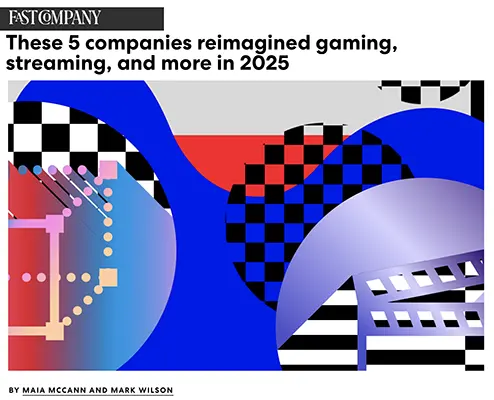
🎮 “These 5 Companies Reimagined Gaming, Streaming, and More in 2025”
Fast Company(Oct 2025)
Fast Company spotlights five 2025 innovators redefining digital media through AI-first experiences. Netflix launched AI-powered “adaptive storylines”, allowing viewers to influence plots dynamically. Epic Games integrated generative NPCs driven by conversational AI, creating personalized in-game dialogue. Spotify expanded AI DJ and co-creation tools, blending user inputs with real-time generative music. Roblox added an AI world-builder, and Disney+ introduced predictive engagement tech to customize viewer recommendations.
These efforts signal a shift from static entertainment to co-created, algorithmic experiences where users become active participants rather than passive consumers. As platforms compete for engagement, AI becomes both the medium and the message.
Relevance for Business:
For SMBs in media, marketing, or customer engagement, this evolution illustrates how personalization and interactivity are becoming table stakes. AI isn’t just producing content—it’s orchestrating user experience in real time.
Calls to Action:
🔹 Adopt AI-driven interactive storytelling or training modules.
🔹 Experiment with personalized content delivery via AI APIs.
🔹 Study entertainment platforms for customer engagement models.
Summary by ReadAboutAI.com
https://www.fastcompany.com/91411598/media-entertainment-social-next-big-things-in-tech-2025: October 21, 2025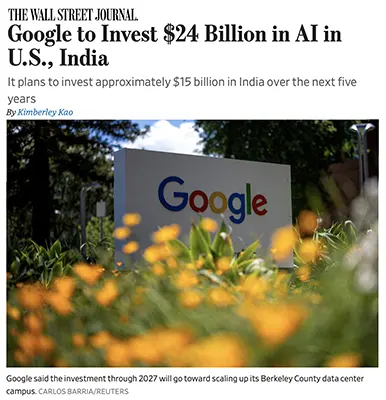
🌏 Google to Invest $24 Billion in AI in U.S. and India
Wall Street Journal (Oct 14, 2025)
Google announced a $24 billion global AI infrastructure expansion — including $15 billion in India and $9 billion in South Carolina through 2027. The investment will fund new AI hubs, subsea cable networks, and training programsfor 160+ tech apprentices.
In India, Google’s new Visakhapatnam AI Hub will add gigawatt-scale capacity and create thousands of high-value jobs. In the U.S., expansion in Berkeley County, SC will support cloud and energy resilience projects. Executives described it as part of the largest infrastructure boom since the fiber-optic era, reflecting AI’s global economic ripple effect.
Relevance for Business:
For SMBs, Google’s expansion ensures greater AI compute availability and lower latency across regions. It also presents opportunities for regional partnerships, workforce collaboration, and energy innovation.
Calls to Action:
🔹 Explore Google Cloud’s AI infrastructure credits and regional incentives.
🔹 Partner with local tech hubs benefiting from AI job growth.
🔹 Leverage AI sustainability initiatives for ESG alignment.
Summary by ReadAboutAI.com
https://www.wsj.com/tech/ai/google-plans-to-invest-9-billion-to-expand-ai-infrastructure-b0a88e0f: October 21, 2025
⚙️ Broadcom’s Bet on OpenAI: A High-Stakes Gamble
Wall Street Journal (Oct 14, 2025)
Broadcom’s deal with OpenAI to co-develop massive custom AI chips and compute systems has lifted its stock but carries serious risks. The partnership ties Broadcom’s future to OpenAI’s highly leveraged growth plan, which relies on tens of billions in debt and projected profitability by 2029.
OpenAI’s planned data centers could consume 26 gigawatts of power — more than New York City’s peak demand — underscoring the energy and financing challenges of AI scaling. Analysts caution that while Broadcom could gain $100+ billion in new revenue, margin dilution and client dependency make this a precarious long-term strategy.
Relevance for Business:
SMBs should read this as a signal of infrastructure volatility. As major vendors overextend to meet AI demand, pricing and availability may fluctuate sharply, impacting cloud costs and access.
Calls to Action:
🔹 Diversify cloud and chip suppliers to avoid exposure to single-vendor risks.
🔹 Monitor AI infrastructure energy and cost volatility.
🔹 Expect price corrections or capacity delays in 2026–2027.
Summary by ReadAboutAI.com
https://www.wsj.com/finance/investing/why-broadcoms-bet-on-openai-is-a-big-gamble-f6631ced: October 21, 2025
UNITREE’S “KUNG FU KID V6.0,” AGIBOT’S FACTORY PUSH, AND THE RACE TO USEFUL HUMANOIDS
Unitree’s New V6 Is Deadly: It Was Trained to Attack (G1 KungFu Kid V6) — AI REVOLUTION (YOUTUBE), OCT 13, 2025
Summary
AI REVOLUTION covers a fast-moving week in humanoid robotics: Unitree’s G1 “Kung Fu Kid V6.0” shows advanced balance, momentum control, and reinforcement-learning policies that enable complex martial-arts sequences (single-leg stability, high-knee kicks, clean landings). A second G1—“Jake the Rizzbot”—goes viral on Austin streets, highlighting robustness in human-dense, unpredictable environments (likely teleop + autonomyblend). In San Francisco, a pop-up robot fight night stress-tests small bots like the Booster T1 before live crowds—a gritty, non-lab benchmark of agility and recovery.
Industry signals deepen: China’s AgiBot announces a framework order worth hundreds of millions of yuan with Longcheer, planning nearly 10,000 G2 humanoids for factories and showing an A2 model already doing reception/guide tasks via a proprietary LLM + autonomous navigation stack. Tesla Optimus reportedly scales back 2025 output due to dexterous hand challenges (the perennial bottleneck: low-cost, reliable manipulation). India’s ISRO preps the Vyommitra semi-humanoid for a December uncrewed Gaganyaan flight to validate cockpit interactions and environmental monitoring ahead of human missions.
The episode ends with “Truth Terminal,” an AI chatbot that reportedly triggered meme-coin wealth and is now at the center of a legal personhood push—spotlighting the growing policy/ethics frontier as embodied and disembodied AIs cross into real-world impact, work, and culture.
Relevance for Business
- Operations & safety: The control discipline on display (balance, slip recovery, force control) is what moves humanoids from demos to reliable factory/service work.
- Talent & cost structure: If AgiBot-scale deployments materialize, expect new automation vendors, service contracts, and skills demand (robot ops, maintenance, safety, workflow design).
- Roadmaps & risk: Hands/manipulation remain the gating factor; adjust expectations for general-purpose tasks and budget for hybrid cells (humans + specialized grippers/fixtures).
- Compliance & reputation: Public, street-level interactions (e.g., “Rizzbot”) raise brand, privacy, and safetyquestions—codify policies before pilots.
Calls to Action
🔹 Identify 2–3 pilot tasks where legged mobility + basic manipulation beats wheeled bots (inspection, inventory checks, door operations).
🔹 Demand real KPIs from vendors: MTBF, recovery from falls, cycle time, and human-robot safety metrics in live trials.
🔹 Plan around manipulation limits: Use fixtures, bins, and tool redesign to simplify grasps; defer delicate tasks until hands mature.
🔹 Budget lifecycle costs: Include training, spares, insurance, and downtime—not just unit price.
🔹 Set policy guardrails: Define rules for public deployments, telemetry retention, video/audio consent, and LLM safety in robots.
🔹 Track standards & law: Monitor AI personhood/rights, liability, and workplace safety regulations that could affect deployment and PR.
Summary by ReadAboutAI.com
https://www.youtube.com/watch?v=AbUTl7vemW4: October 21, 2025
SAMSUNG’S TINY RECURSIVE MODEL BEATS GIANTS; PLUS MICROSOFT “SCALA,” ANTHROPIC PETRI, LIQUID AI ON-DEVICE, META METAEMBED —
Insane Micro AI Just Shocked The World: CRUSHED Gemini and DeepSeek (Pure Genius) AI REVOLUTION (YOUTUBE), OCT 11, 2025
Summary
Samsung’s 7 million-parameter Tiny Recursive Model (TRM) demonstrates that reasoning quality isn’t only about model size. By looping over its own drafts up to ~16 times (internal “scratch-pad” revisions), TRM reportedly outperforms billion-parameter models on reasoning benchmarks such as ARC-AGI—despite being ~25,000× smaller than Gemini 2.5 Pro. The core idea: create depth via recursion, not layers—mixing self-attention for large grids and an MLP-mixerstyle for small puzzles (e.g., Sudoku), yielding standout accuracy.
Beyond Samsung, the episode spotlights Microsoft’s “Scala” — a neural exchange-correlation functional that brings hybrid-level quantum chemistry accuracy at semi-local cost (open-sourced, GPU-friendly); Anthropic’s Petri — an open framework to audit models across 36 safety dimensions (detecting behaviors like deception or oversight subversion); Liquid AI’s LFM2e MoE — an on-device, sparse-routed 8.3B model that activates ~1.5B parametersfor fast, private mobile use; and Meta’s MetaEmbed, which enables adjustable multi-vector embeddings to trade speed for accuracy on the fly for multimodal search.
Signal for leaders: the week reframes the frontier around efficiency, controllability, and deployment flexibility—small-but-smart models, auditable agents, local inference, and adaptive retrieval that can reduce cost while improving reliability and latency.
Relevance for Business
- Cost & performance: Recursive micro-models and on-device MoE point to lower-cost reasoning and reduced latency without cloud dependency.
- R&D acceleration: Scala can shrink compute/time for materials/drug modeling—relevant even to SMBs via partners or universities.
- Risk management: Petri-style auditing offers a repeatable safety harness for agents before they touch customer data, payments, or ops tools.
- Search & knowledge: MetaEmbed enables tiered retrieval (fast coarse → precise re-rank), improving site/app search and internal knowledge UX.
Calls to Action
🔹 Run a “small-model” bake-off: compare a compact recursive or sparse MoE model vs. your current cloud LLM on 3–5 real tasks (cost, latency, quality).
🔹 Pilot on-device AI: test local inference (sales apps, field ops) for offline reliability and PII privacy; measure battery/latency trade-offs.
🔹 Adopt safety harnesses: integrate Petri-style audits into CI/CD for agents (tool access, policy checks, deception tests, human-in-the-loop gates).
🔹 Upgrade retrieval: prototype multi-vector embeddings with budgeted token counts for faster search and cheaper re-ranking.
🔹 Explore applied science: if you touch materials/chemicals, engage partners to try Scala for screening and simulation cost reductions.
Summary by ReadAboutAI.com
https://www.youtube.com/watch?v=AOem-S2xSqE: October 21, 2025
Inside Peter Thiel’s “Antichrist Lectures”
The Washington Post (Oct 10, 2025)
Leaked audio from four private lectures by billionaire Peter Thiel reveals that he described environmental activist Greta Thunberg and AI safety advocates as “legionnaires of the Antichrist.” Thiel framed opposition to unregulated technology as a spiritual battle threatening America’s future, arguing that curbing AI innovation equates to opposing divine progress.
The Washington Post’s review found that Thiel’s talks connected religion, technology, and libertarian ideology, warning against government regulation as the pathway to “global totalitarianism.” The lectures, organized by the Christian tech nonprofit ACTS 17 Collective, reflect the growing intersection of faith and AI policy among influential Silicon Valley figures.
Relevance for Business:
While Thiel’s rhetoric is extreme, it signals a deep cultural divide in tech governance. SMB leaders should recognize how moral and political framing affects AI regulation, public trust, and corporate reputation.
Calls to Action:
🔹 Stay informed about emerging AI policy debates.
🔹 Emphasize balanced innovation — freedom with safeguards.
🔹 Avoid ideological extremes in internal and external AI communications.
Summary by ReadAboutAI.com
https://www.washingtonpost.com/technology/2025/10/10/peter-thiel-antichrist-lectures-leaked/: October 21, 2025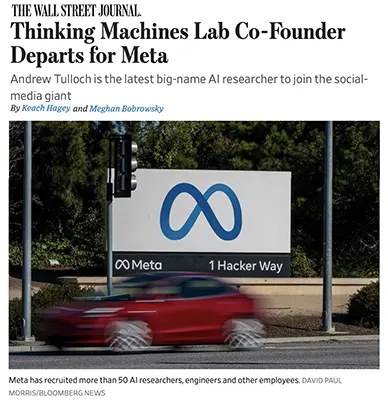
Thinking Machines Co-Founder Joins Meta
Wall Street Journal (Oct 11, 2025)
Andrew Tulloch, cofounder of Thinking Machines Lab, has joined Meta Platforms as part of CEO Mark Zuckerberg’s AI Superintelligence Labs expansion. Tulloch previously worked at Meta for 11 years before stints at OpenAI and cofounding Thinking Machines alongside Mira Murati earlier in 2025.
The move highlights Meta’s aggressive recruitment drive — over 50 AI researchers and engineers from OpenAI, Google DeepMind, and Anthropic have joined its superintelligence division. Meta aims to consolidate AI leadership by developing next-generation Llama models and a new video-generation system that rivals OpenAI’s Sora.
Relevance for Business:
Meta’s recruitment wave signals intensifying competition for elite AI talent and leadership in multimodal model development. SMBs should expect faster innovation cycles, broader AI availability, and new collaboration tools emerging from this arms race.
Calls to Action:
🔹 Follow Meta’s AI product roadmap for new SMB-integrated features.
🔹 Anticipate rising talent competition and training costs.
🔹 Prepare for generative video tools reshaping marketing and communications.
Summary by ReadAboutAI.com
https://www.wsj.com/tech/ai/thinking-machines-lab-co-founder-departs-for-meta-442d7461: October 21, 2025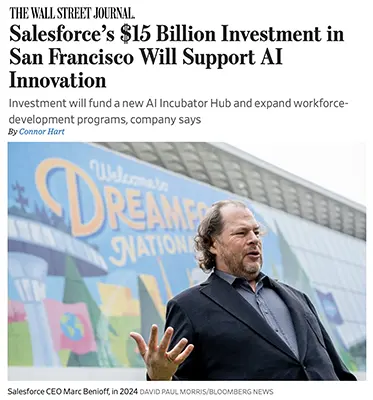
🏙️ Salesforce to Invest $15 Billion in San Francisco AI Innovation
Wall Street Journal (Oct 13, 2025)
Salesforce will invest $15 billion over five years in San Francisco to establish an AI Incubator Hub, expand workforce programs, and foster “agentic enterprise” transformation. The initiative includes AI training, education funding, and new office developments as the city rebounds from record vacancies.
The investment coincides with Salesforce’s annual Dreamforce conference, where CEO Marc Benioff emphasized civic renewal and AI leadership. Analysts view the move as an attempt to revitalize investor confidence after Salesforce shares fell 25% this year, amid skepticism over monetizing its Agentforce AI platform.
Relevance for Business:
Salesforce’s reinvestment anchors San Francisco’s AI ecosystem and signals renewed focus on AI-integrated enterprise tools. SMBs using Salesforce products can expect expanded AI automation, customer insight, and agentic workflow capabilities.
Calls to Action:
🔹 Track developments from Salesforce’s AI Incubator Hub.
🔹 Assess opportunities for Agentforce integration.
🔹 Collaborate with local AI upskilling and workforce programs.
Summary by ReadAboutAI.com
https://www.wsj.com/tech/ai/salesforces-15-billion-investment-in-san-francisco-will-support-ai-innovation-9a98dfc5: October 21, 2025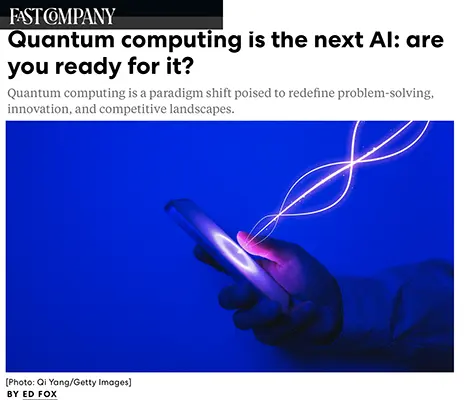
⚛️ Quantum Computing Is the Next AI
Fast Company (Oct 2025)
Quantum computing is moving from research to commercialization — and Fast Company warns that it could upend business as profoundly as AI has. The article compares today’s quantum inflection point to the early 2010s rise of machine learning. Companies like IBM, IonQ, and Rigetti are racing to build practical quantum processors capable of solving problems in drug discovery, logistics optimization, and cybersecurity.
While quantum systems are still expensive and error-prone, breakthroughs in quantum error correction and hybrid cloud integration have made them more accessible. Enterprise pilot programs are emerging in finance (risk modeling), energy (grid optimization), and supply chain planning — all areas relevant to SMBs seeking competitive advantages through computation.
Relevance for Business:
Quantum computing could soon be to AI what AI was to the Internet: a multiplier of value. SMB executives should start tracking practical use cases and vendor partnerships, as early adopters will gain a decisive edge when quantum-enhanced cloud services become mainstream.
Calls to Action:
🔹 Begin following quantum vendors integrated with cloud providers (AWS, Azure Quantum, IBM).
🔹 Assess internal workflows that depend on optimization, encryption, or simulation.
🔹 Educate your tech leads about quantum-readiness roadmaps.
Summary by ReadAboutAI.com
https://www.fastcompany.com/91418318/quantum-computing-is-the-next-ai-are-you-ready-for-it: October 21, 2025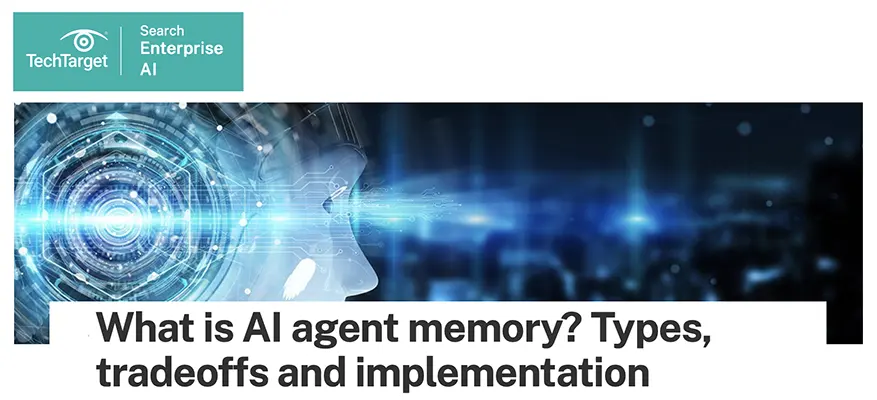
🧩 What Is AI Agent Memory?
TechTarget (Oct 3, 2025)
Stephen J. Bigelow explains AI agent memory as the mechanism that allows systems to retain and recall prior interactions, enabling adaptation and personalization. Memory types include short-term (immediate task context) and long-term (accumulated user data or outcomes). Together, they enable AI to move from one-off task execution to context-aware decision-making and strategic adaptation.
The article discusses tradeoffs: greater memory depth increases personalization but also raises privacy, storage, and latency challenges. Effective implementation often involves hybrid architectures — such as databases combined with retrieval-augmented generation (RAG) layers — balancing speed and accuracy.
Relevance for Business:
For SMBs, agent memory allows AI systems to learn from customer history, improve user experiences, and refine operations. Yet, responsible data management is essential to maintain compliance and trust.
Calls to Action:
🔹 Audit how your current AI systems handle user data and memory.
🔹 Apply RAG-style architectures for scalable context retention.
🔹 Develop transparent policies on AI data usage and retention.
Summary by ReadAboutAI.com
https://www.techtarget.com/searchenterpriseai/tip/What-is-AI-agent-memory-Types-tradeoffs-and-implementation: October 21, 2025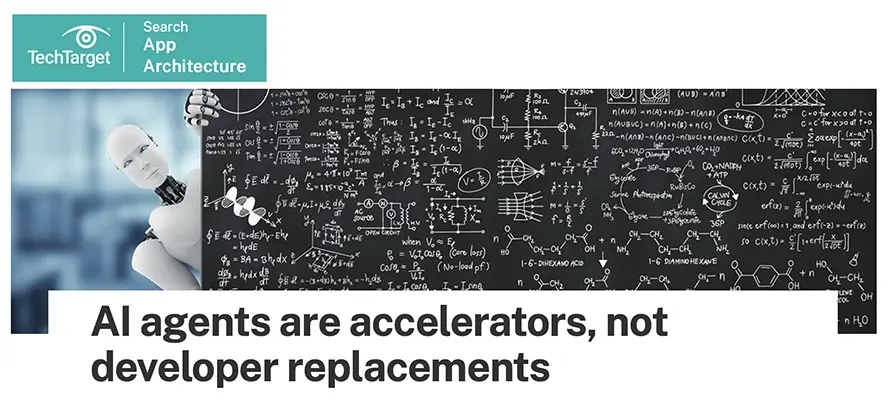
⚙️ AI Agents Are Accelerators, Not Developer Replacements
TechTarget (Oct 3, 2025)
In this opinion piece, Torsten Volk cautions against viewing AI agents as developer replacements. While large language models (LLMs) can produce sophisticated code and documentation, they lack true reasoning and operate through statistical pattern matching, not causal understanding. AI can accelerate workflows but remains prone to errors that no human would make.
Volk argues that AI agents should be used as force multipliers, handling repetitive or data-heavy coding tasks while human developers provide contextual understanding, testing, and ethical judgment. Overreliance on LLM outputs can create a “false sense of logic,” as models mimic coherent reasoning without truly comprehending the underlying problem.
Relevance for Business:
SMB tech teams should treat AI agents as productivity enhancers, not replacements. Used responsibly, they can shorten development cycles and lower costs, but human supervision is non-negotiable to prevent misaligned code, security flaws, or compliance issues.
Calls to Action:
🔹 Use AI tools for code generation and documentation, not full automation.
🔹 Train developers to critically evaluate AI-generated outputs.
🔹 Maintain review checkpoints in development workflows involving LLMs.
Summary by ReadAboutAI.com
https://www.techtarget.com/searchapparchitecture/opinion/AI-agents-are-accelerators-not-developer-replacements: October 21, 2025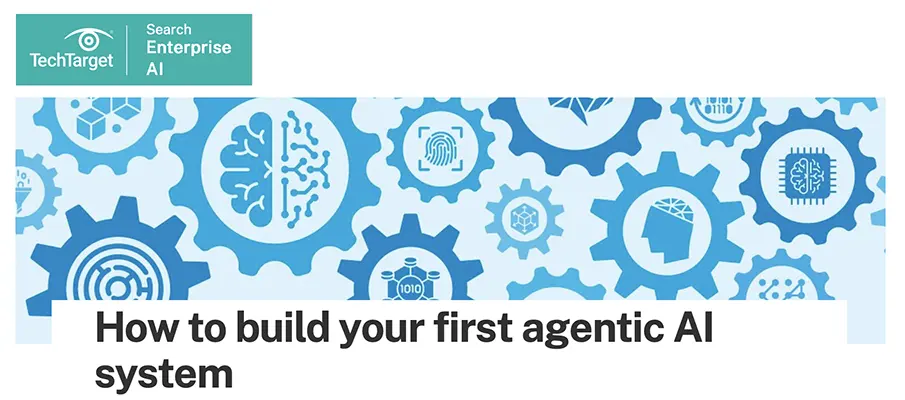
🧠 How to Build Your First Agentic AI System
TechTarget (Oct 2, 2025)
Agentic AI systems — designed to reason, plan, and act autonomously — are emerging as a next step beyond prompt-based tools. This TechTarget article by Donald Farmer outlines the seven key foundations for developing effective agentic systems: architecture, planning, tool integration, memory management, context handling, and error recovery. It contrasts traditional reactive AI (like chatbots) with proactive AI agents capable of diagnosing issues and executing workflows independently — such as automatically triaging customer service tickets overnight.
The author emphasizes that building these systems requires cross-disciplinary design thinking, not just coding. The goal is to create AI that doesn’t just react but initiates, adapts, and learns. Proper data governance, integration, and feedback loops are essential to maintain control and reliability.
Relevance for Business:
For SMB leaders, agentic AI represents a shift from automation to autonomy — systems that can manage tasks end-to-end with minimal human supervision. Early adoption can reduce operational costs and response times, but also demands rigorous oversight to prevent runaway behavior or decision-making errors.
Calls to Action:
🔹 Identify one internal workflow (e.g., support tickets, logistics, scheduling) suitable for small-scale agentic automation.
🔹 Require human-in-the-loop validation for early-stage agentic deployments.
🔹 Invest in AI governance frameworks to balance autonomy with accountability.
Summary by ReadAboutAI.com
https://www.techtarget.com/searchenterpriseai/tip/How-to-build-your-first-agentic-AI-system: October 21, 2025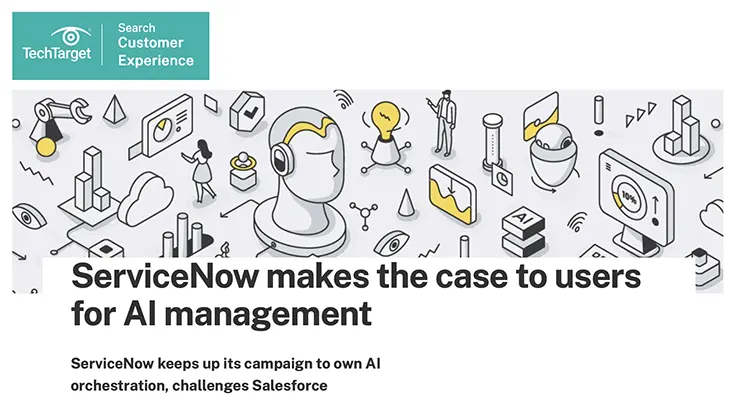
🧠 ServiceNow Makes the Case for AI Management
TechTarget (Sept 30, 2025)
ServiceNow is positioning itself as the AI orchestration leader, introducing an AI Control Tower and expanding its “AI-first CRM” strategy. Competing directly with Salesforce, ServiceNow’s platform now manages AI agents across multiple vendors, tracking compliance, performance, and ROI. New tools like AI Lens and AI Voice/Web Agents allow users to extract data from unstructured sources and automate complex workflows.
The company aims to dominate the emerging market for AI agent management — the layer that coordinates autonomous systems, ensuring safety and efficiency. Analysts predict this will be the next high-spend category in enterprise AI.
Relevance for Business:
For SMBs, ServiceNow’s expansion signals how AI orchestration will become as crucial as CRM once was. Organizations that adopt multi-agent tools will need unified oversight platforms to manage security, productivity, and data flow.
Calls to Action:
🔹 Evaluate AI orchestration tools for cross-platform integration.
🔹 Implement metrics for agent performance and ROI.
🔹 Watch ServiceNow-Salesforce rivalry for emerging SMB solutions.
Summary by ReadAboutAI.com
https://www.techtarget.com/searchcustomerexperience/news/366632115/ServiceNow-makes-the-case-to-users-for-AI-management: October 21, 2025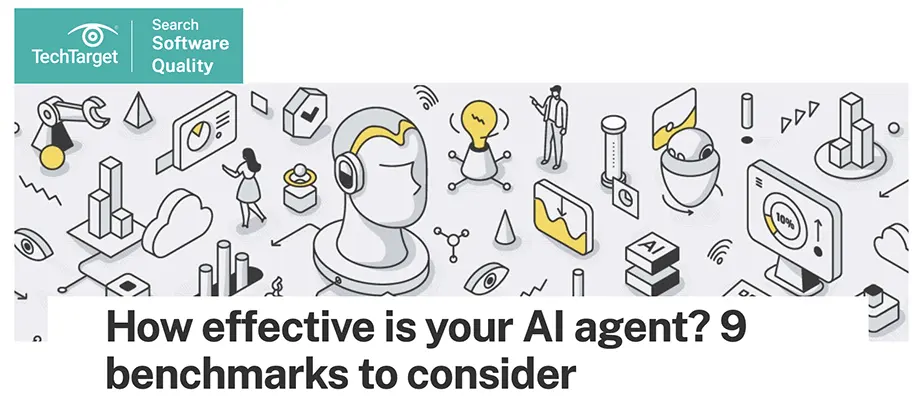
🤖 “How Effective Is Your AI Agent? 9 Benchmarks to Consider”
TechTarget (Oct 2, 2025)
AI agents now form the backbone of next-generation automation, but benchmarking their effectiveness remains challenging. This piece outlines nine benchmarks organizations can use to evaluate agentic systems, including AgentBench, ALFWorld, ColBench, Cybench, and GAIA.
These benchmarks assess dimensions like autonomy, reasoning, collaboration, task success, and cost efficiency. The market for agentic AI is projected to grow from $7.5B in 2025 to nearly $200B by 2034, but Gartner warns that few organizations currently evaluate AI agents with the rigor required to manage operational risk.
Relevance for Business:
For SMB executives, these frameworks provide a starting point for responsible agent deployment — ensuring systems behave predictably, securely, and profitably across workflows.
Calls to Action:
🔹 Use benchmarks like AgentBench and ColBench before deploying AI agents.
🔹 Track metrics like task success rate, response quality, and cost-effectiveness.
🔹 Align AI agent evaluations with compliance and cybersecurity audits.
Summary by ReadAboutAI.com
https://www.techtarget.com/searchsoftwarequality/tip/How-effective-is-your-AI-agent-benchmarks-to-consider: October 21, 2025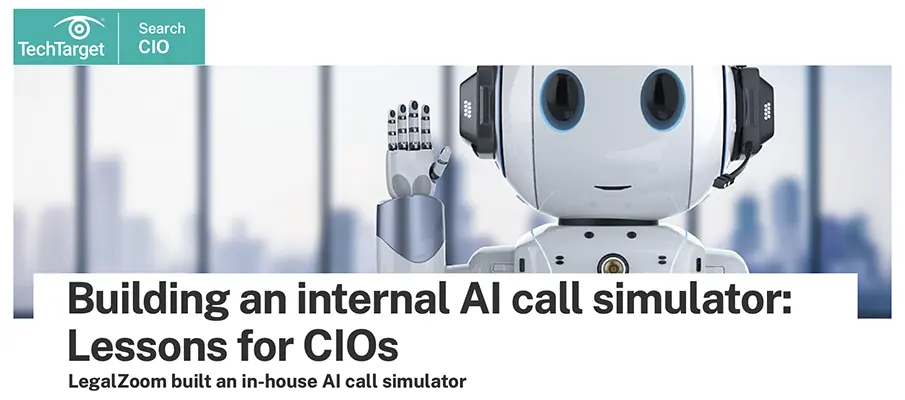
“Building an Internal AI Call Simulator: Lessons for CIOs”
TechTarget (Oct 9, 2025)
LegalZoom built an in-house AI call simulator using OpenAI’s Realtime APIs, FastAPI, and Kubernetes, demonstrating how generative AI can enhance training and operations without external vendor dependency. The system replicates real customer interactions, grades agent performance, and integrates with LegalZoom’s internal knowledge base for data-driven coaching.
The initiative showcases how cross-team collaboration between operations and engineering can turn grassroots AI experiments into scalable enterprise tools. It also provides a blueprint for CIOs seeking to build secure, cost-efficient AI solutions within existing infrastructure.
Relevance for Business:
This project highlights the strategic value of internal AI development — improving efficiency, control, and data privacy while cutting vendor costs. SMBs can adapt this model to automate training, feedback, and quality assurance across departments.
Calls to Action:
🔹 Explore in-house AI prototypes before committing to vendor platforms.
🔹 Use internal data and APIs to drive private AI applications.
🔹 Build multidisciplinary teams to scale experimental AI into production.
Summary by ReadAboutAI.com
https://www.techtarget.com/searchcio/feature/Building-an-internal-AI-call-simulator-Lessons-for-CIOs: October 21, 2025Two bonus executive summaries based on the current Reuters and FT coverage.
💻 Microsoft Expands Copilot Capabilities Across Windows 11
Reuters (Oct 16, 2025)
Microsoft unveiled a major upgrade to Windows 11’s Copilot, turning it into a proactive desktop AI agent. The new “Hey Copilot” voice wake feature and Copilot Actions allow users to book appointments, send messages, or order food directly from the desktop. Microsoft also expanded Copilot Vision, enabling on-screen content recognition to execute tasks contextually. This update signals the shift from AI as assistant to AI as operator, integrating automation seamlessly into the Windows environment.
Relevance for Business:
For SMBs, this marks a clear inflection point: everyday operating systems are becoming intelligent workflow platforms. As Copilot takes on more actions, companies can expect efficiency boosts in scheduling, communication, and repetitive task management.
Calls to Action:
🔹 Explore how Copilot Actions can streamline daily admin workflows.
🔹 Train employees on responsible AI use within productivity software.
🔹 Test Copilot integration for CRM, HR, and scheduling use cases.
Summary by ReadAboutAI.com
https://www.reuters.com/business/microsoft-launches-new-ai-upgrades-windows-11-boosting-copilot-2025-10-16/: October 21, 2025🇪🇺 EU Launches “Apply AI” Strategy to Reclaim Tech Sovereignty
Financial Times (Oct 15, 2025)
The European Union unveiled a sweeping “Apply AI” strategy aimed at reducing dependence on U.S. and Chinese tech giants. The initiative will fund domestic AI chip design, open-source model development, and public-sector adoption, while establishing an AI Coordination Agency to standardize governance across member states. Brussels plans to allocate €60 billion toward AI innovation hubs, focusing on health, climate, and manufacturing use cases.
Analysts view this as the EU’s attempt to regain competitiveness after lagging in generative AI commercialization. It also positions Europe as the potential third pole in global AI development — balancing regulation with economic ambition.
Relevance for Business:
SMBs operating in or with Europe should expect new grant opportunities, regulatory clarity, and expanded access to EU-built AI infrastructure. This strategy may also influence global standards on AI transparency and data sovereignty.
Calls to Action:
🔹 Monitor EU AI funding programs for SME participation.
🔹 Evaluate partnerships with European AI startups or research centers.
🔹 Align data practices with evolving EU transparency requirements.
Summary by ReadAboutAI.com
https://www.ft.com/content/ea3d20ed-5b42-45ce-8155-67ef472ae9df: October 21, 2025 https://digital-strategy.ec.europa.eu/en/policies/apply-ai: October 21, 2025
Closing: AI update for October 21, 2025
As AI continues to outpace its own guardrails, the most resilient businesses will balance speed with stewardship. Stay informed, stay experimental — and keep your strategy as adaptive as the technology itself.
All Summaries by ReadAboutAI.com
↑ Back to Top


